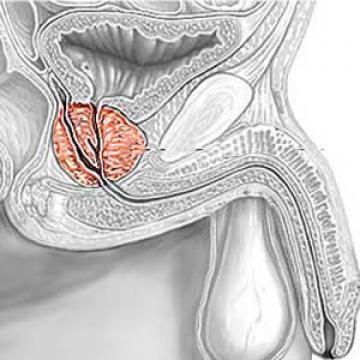Carcinoma of Prostate

Prostate cancer is the most common cancer to affect Canadian men. One in seven men will be diagnosed with the disease in their lifetime.
Prostate cancer is a disease where some prostate cells have lost normal control of growth and division. They no longer function as healthy cells.
A cancerous prostate cell has the following features:
- Uncontrolled growth
- Abnormal structure
- The ability to move to other parts of the body (invasiveness).
Pathophysiology: Prostate cancer develops when the rates of cell division and cell death are no longer equal, leading to uncontrolled tumor growth. Following the initial transformation event, further mutations of a multitude of genes, including the genes for p53 and retinoblastoma, can lead to tumor progression and metastasis. Most prostate cancers (95%) are adenocarcinomas.
Clinical features: Common signs and symptoms of prostate cancer may include:
- Difficulty urinating
- Urgent need to urinate
- Frequent urination, especially at night
- Burning or pain when urinating
- Inability to urinate or difficulty starting or stopping urine flow
- Painful ejaculation
- Blood in the urine or semen
Risk Factors (causes)
Age: The chance of getting prostate cancer rises quickly after a man reaches age 50. Age is the most important risk factor for prostate cancer.
Race: Prostate cancer is more common in men of African or Caribbean descent and less common in men of Asian descent.
Family history: Genetics plays a role - the risk of prostate cancer increases if close family members have had the disease.
Diet: Men who eat a low-fibre, high-fat diet have a higher rate of prostate cancer. Research suggests that saturated fat (commonly found in processed foods, whole-milk dairy products and fatty cuts of meat) increases the production of the hormone testosterone, which may help prostate cancer cells grow.
Lifestyle: Having a high Body Mass Index (BMI) may increase the risk of prostate cancer. Being physically active is a good preventative tactic, along with losing weight and eating the right foods. Consuming lycopene (found in tomatoes and tomato products), soy, green tea and cruciferous vegetables (such as broccoli), among other foods and nutrients, may help to prevent prostate cancer.
Differential Diagnoses
- Acute Bacterial Prostatitis and Prostatic Abscess
- Bacterial Prostatitis
- Benign Prostatic Hypertrophy
- Nonbacterial Prostatitis
- Tuberculous Prostatitis
Management of Advanced and Metastatic Disease: A rise in PSA after radical prostatectomy to greater than 0.2 ng/mL or 3 consecutive PSA increases after radiation therapy are evidence of impending disease progression. Not all men who have a rising PSA will develop metastases, and for that reason not all such men require treatment. The risk of metastases and death depend on the patient’s Gleason score, the length of time between the nadir PSA and the onset of the PSA’s rise, and the PSA doubling time.
Patients who have PSA (biochemical) failure following radical prostatectomy and have no evidence of metastatic disease have the options of watchful waiting, radiation therapy, or hormone ablation as salvage therapy
Investigation
Prostatic specific antigen test (PSA) is a protein produced by the prostate gland which normally leaks into the bloodstream. The PSA test measures the level of PSA in your bloodstream so your doctor will ask for a blood sample.
Prostate biopsy: A biopsy is the removal of a small sample of tissue for examination under the microscope. By looking at the cells from your prostate gland, the doctors can confirm the presence of cancer.
Flow rate: This is a simple test to observe your urine flow. You will be asked to pass urine into a funnel connected to a computer. The computer provides a print-out of any difficulties you may be having.
Complications
Cancer that spreads (metastasizes): Prostate cancer can spread to nearby organs, such as your bladder, or travel through your bloodstream or lymphatic system to your bones or other organs. Prostate cancer that spreads to the bones can cause pain and broken bones. Once prostate cancer has spread to other areas of the body, it may still respond to treatment and may be controlled, but it can no longer be cured.
Incontinence: Both prostate cancer and its treatment can cause urinary incontinence. Treatment for incontinence depends on the type you have, how severe it is and the likelihood it will improve over time. Treatment options may include medications, catheters and surgery.
Erectile dysfunction: Erectile dysfunction can be a result of prostate cancer or its treatment, including surgery, radiation or hormone treatments. Medications, vacuum devices that assist in achieving erection and surgery are available to treat erectile dysfunction.
Homoeopathic therapeutics: with the help of Homeopathic treatment we can provide better health and improve life style and also help in Incontinence & Erectile dysfunction.






